Our Esprit S4 "S"
Discussion
I would just like to start by saying that I have had a lot of help and advice from Dermot O'Hare from the Esprit forum and Marcus from PUK Racing in Germany (who supplied many of the performance parts) and then added a few of my own ideas from contacts within the industry.
As standard the Esprit is pretty crap, it has terrible brakes (260mm with sliding callipers) and the alleged factory 264bhp is supposed to be complimented by a 6s over-boost to 280bhp. The reality is that the factory charge-cooler is pretty poor and these figures are only ever achieved in ideal conditions and for only limited periods before the charge air retard within the map pulls the boost back due to seeing too high temps.
Anyway, the first thing that was done was to upgrade the brakes to the Brembo 4-pots and 330mm discs from the V8, which actually endowed the car with braking that could no longer be described as frightening, and just about adequate for a car of this weight and intended performance LOL:
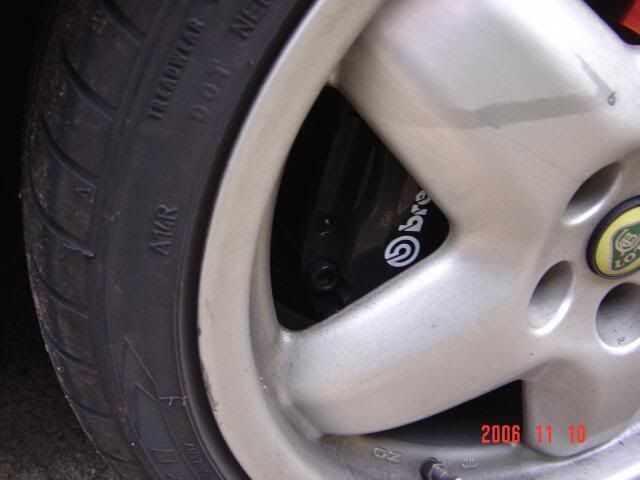
Then when the turbo died on track at Snetterton back in 2006, it was time to do something about it. Now as you are probably aware from my other posts, I like to mod cars, so with my motto of not replacing stuff with standard items, the modifcations began:
The air flow figures of the standard turbo are the limiting factor if you want to make substantial gains in the performance of these cars. Even after changing the EPROM for more fuel, ignition and boost, you cannot get any more sustained power, due to the aforementioned shonky charge-cooling arrangement and small size of the turbo. The bottom line is that turning up the boost on one of these, quickly runs up against the fact that the standard turbo cannot flow enough air at the top end - the result is that the inlet temperature rises very dramatically and boost drops away. In fact, just like RS Turbos, there is common condition in which increasing the boost will actually produce less power output due to the inefficiency of the standard set up.
The S4 is fitted with a Garrett T3 turbo, comprised of standard 270° thrust bearings, 0.63 a/r "Lotus only" turbine housing (as a comparison the T3 on a Cossie (2.0 litre) is 0.48 a/r, but the Esprit is 2.2, so needs better exhaust flow) with an integral wastegate, a standard T3 compressor housing, and a 42 trim compressor wheel, oil fed and water cooled. It has a maximum flow rating of 25 lbs/min at a 1.2 bar of boost, with 58% efficiency. This gives you an idea of how bad the turbo is, as you take the air flow and add 25-30bhp (on a good VE engine) to give the maximum THEORETICAL achievable power with the turbo. Therefore, it was nearly maxed out as standard (and no doubt explains why it let go on track).
The cure? A bigger turbo and better charge-cooler! I chose to replace this with a super-duper hybrid version:
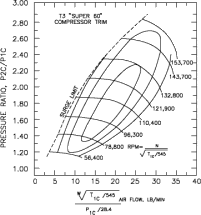
This is similar to the turbo on the S4S, the Garrett T3 turbo was modified by fitting a 60 trim compressor wheel and 360° thrust bearing etc. It has a maximum flow rating of 34 lbs/min at a pressure ratio of 1.3 bar of boost, with 64% efficiency.
Next we move on to the intake system, as there is a lot of air flow lost from the turbo to the throttle body inlets. This was looked at by some racing teams a few years ago, and they found that the standard inlet system lost over 30 cfm of airflow from turbo to the inlet ports . However, with a little matching of the inlet manifold to the ports, gas flowing the nozzle and plenum you could get this down to about 7-8 cfm loss. The race team got the losses from turbo to inlet on the GT1 car down to less than 5 cfm losses! The entry of the nozzle to the plenum is quite restrictive as you can see from the photos. Over 5mm was machined from the entry of the nozzle to the plenum and all the edges were radiused off and matched to the individual gaskets.
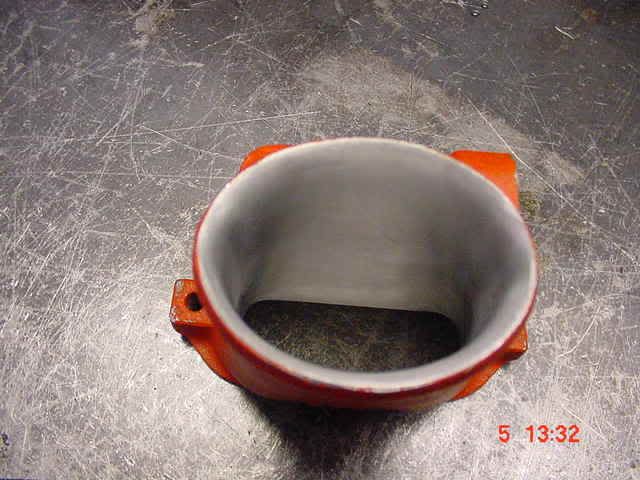
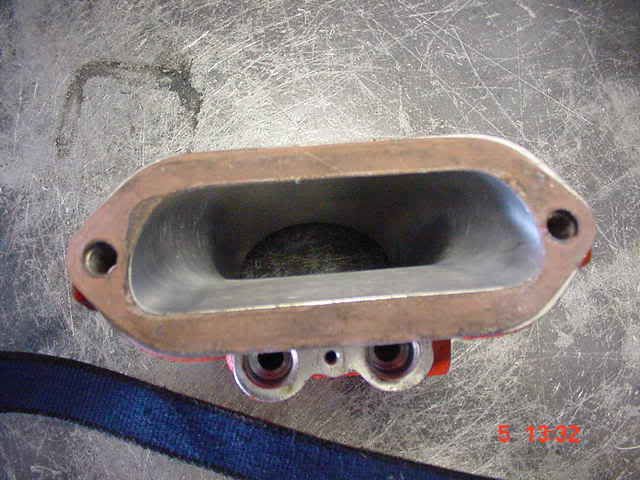
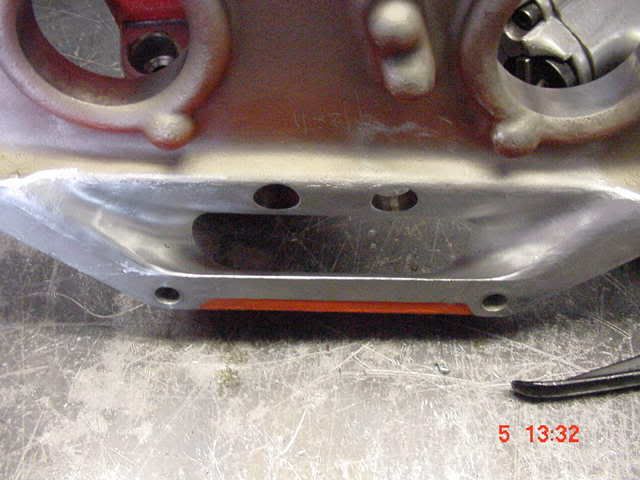
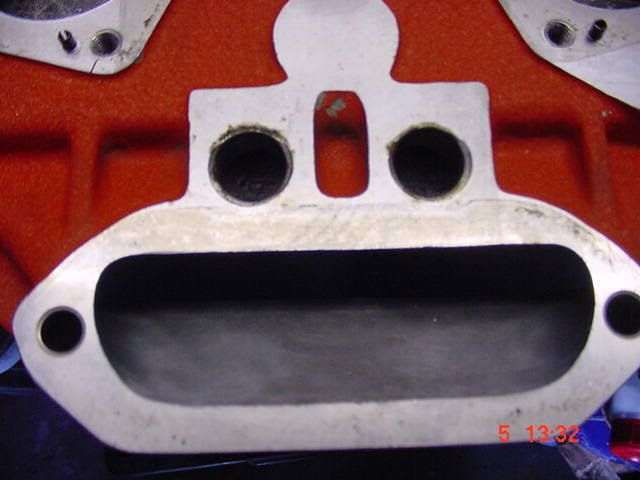
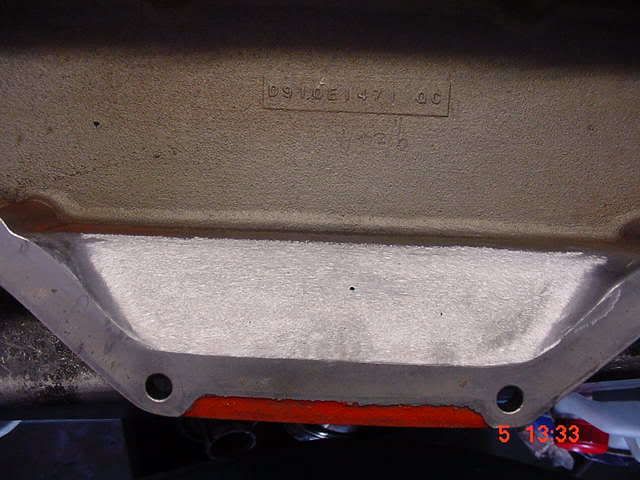
All the 4-cylinder turbo-charged Esprit models since they were face-lifted from the original wedge shape (SE, S4, S4s & GT3) use a chargecooler (basically a water cooled intercooler) to reduce the intake temperatures. Unfortunately, in standard size these suffer from excessive heat soak, so are only good for short blasts of speed. Water is pumped via alloy pipes routed through the chassis backbone, to a chargecooler radiator mounted ahead of both the air conditioning condenser and the engine cooling radiator.
The chargecooler system on our car has been extensively upgraded with a chargecooler double the size of the original. Although the cooling matrix is twice the size of the original, there is no loss in air flow. What results is a much greater cooling efficiency, so now combined with the bigger, more efficient turbo, the power should be much improved.
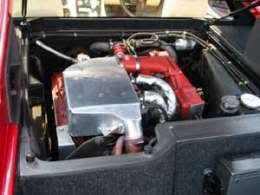
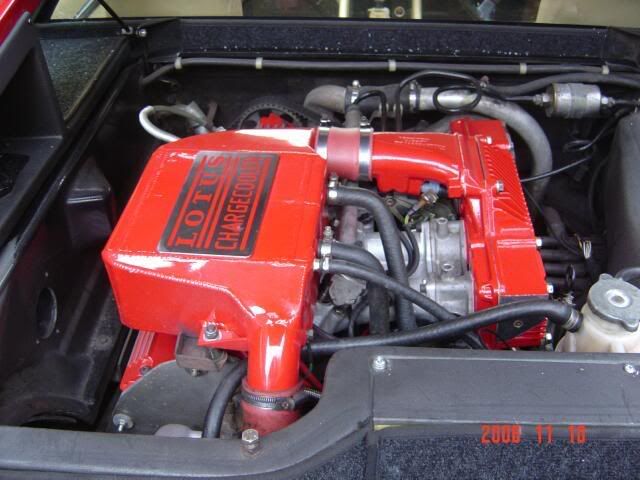
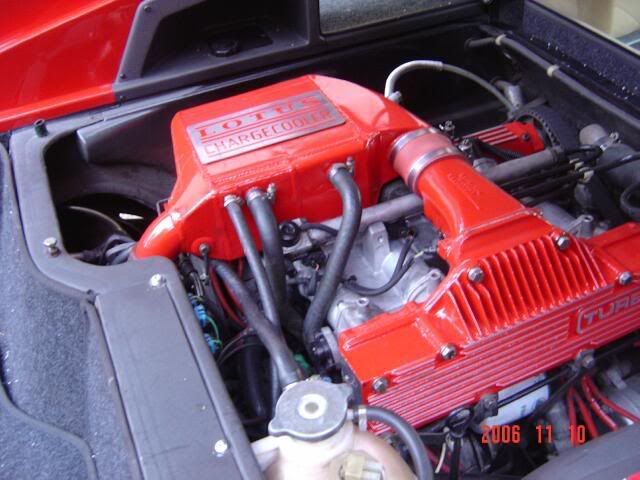
The rubber impellor of the charge-cooler pump is essential to achieve the intended performance from the engine. Sadly the standard item deteriorates slowly with age, progressively robbing power, but due to the slow period that this takes place - you don't notice ops:. The one on ours had actually siezed solid, meaning that the water was only running round due to thermal cycling (like a Model T Ford water system LOL). This impellor is custom made by a company in Germany using the highest quality and most appropriate rubber compound, so that it doesn't have to be changed all over again later in the car's life. Can't believe Lotus didn't do this in the first place :roll:.
ops:. The one on ours had actually siezed solid, meaning that the water was only running round due to thermal cycling (like a Model T Ford water system LOL). This impellor is custom made by a company in Germany using the highest quality and most appropriate rubber compound, so that it doesn't have to be changed all over again later in the car's life. Can't believe Lotus didn't do this in the first place :roll:.
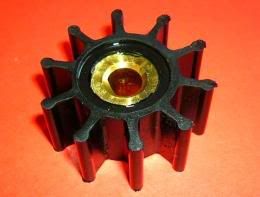
While this was being done, it seemed the sensible time to sort out the rest of the cooling on the car, as the radiator had developed a leak and was believed to be due to the common Esprit problem of it basically having rotted. Sure enough, when everything was stripped off, all was revealed - the radiator was FUBAR'd - as you can see it looks like a bee-hive :
:
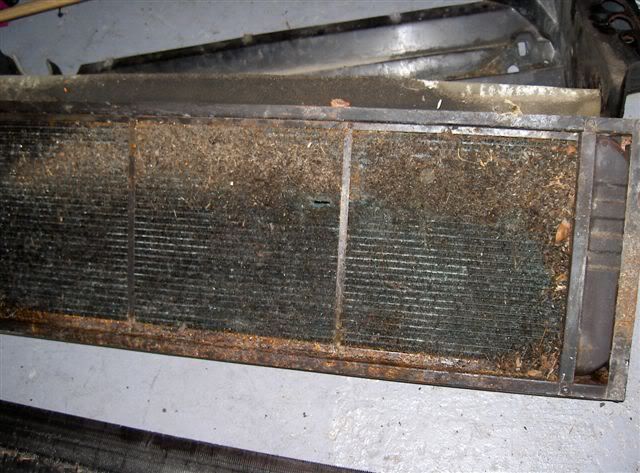
A close up of the main water radiator showing the leaking area - apart from being 50% blocked with road debris - it was as rotten as 6 week old road kill LOL. I think this was because it had always remained damp on the outside due to the sodden crud stuck to it over the years! The front spoiler is designed to channel a huge amount of airflow to the radiators - unfortunately with this comes the dirt and thousands of suicidal insects!
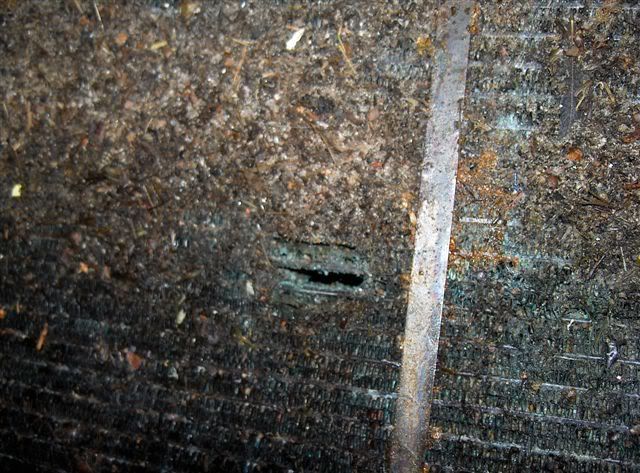
This was the offside oil cooler showing the broken outlet fitting.. Unfortunatley you need to remove this fitting so you can get to the radiator, which subsequently just fell off . As you can see it was in quite a poor condition generally - again down to the efficency of the spoiler and the fact that the flat floor prevents any cleaning access.
. As you can see it was in quite a poor condition generally - again down to the efficency of the spoiler and the fact that the flat floor prevents any cleaning access.
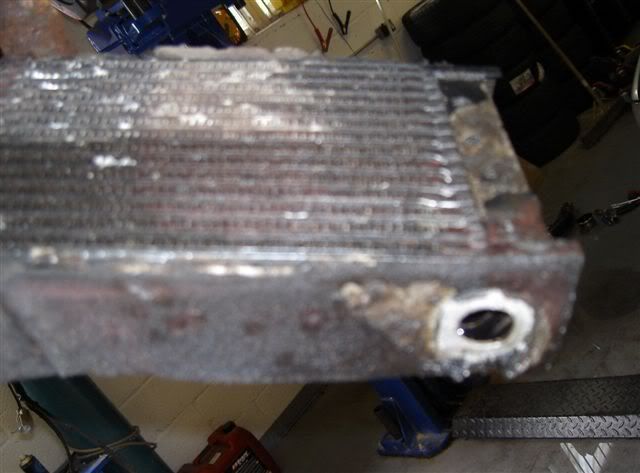
Nearside oil cooler showing damage causing a slight leak:
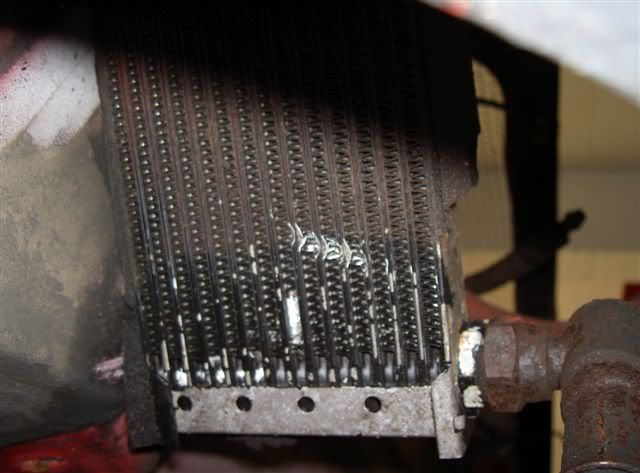
Here is the conjoined charge-cooler radiator and air-con condensor - the lower part is the air con. This appeared to have had a leak as there was no gas in the system! Seems a very inefficient set-up, so I realised this could be vastly improved upon .
.
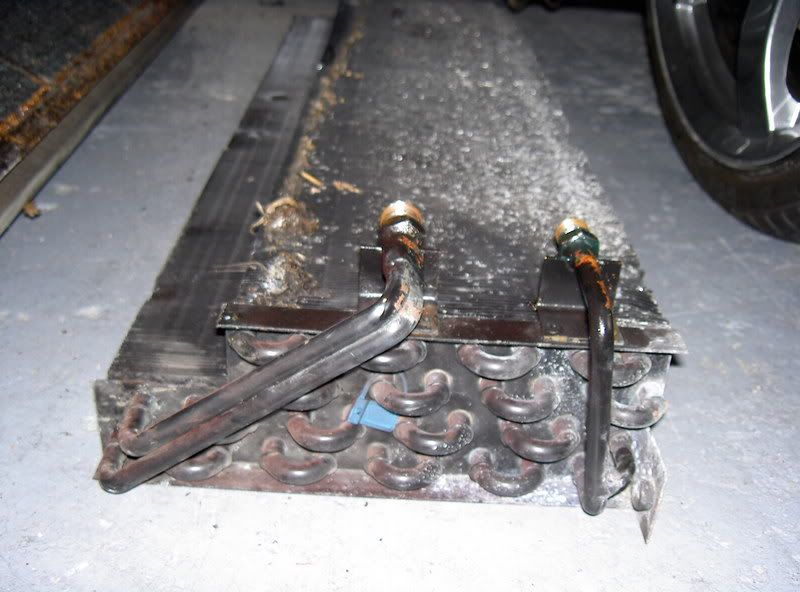
Another view of air con / pre-rad:
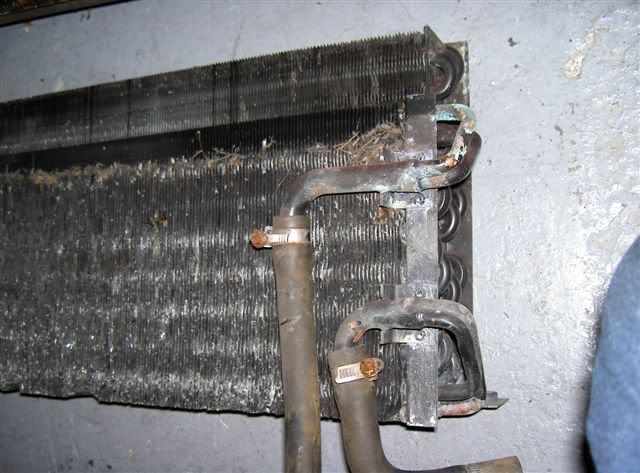
Now the oil coolers have been replaced with brand new ones and the radiator upgraded and a HUGE charge-cooler radiator installed.
Here is the automotive sexual bit courtessy of Pro-Alloy Motorsport :
:
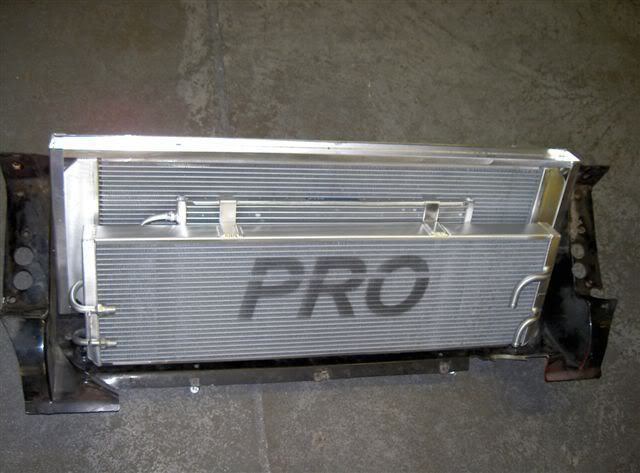
Moving on to the fuelling system, the standard primary GM-Rochester injectors are well known for not being the best injectors on this planet (i.e. cheap rubbish that Lotus obviously got from their American partners when they were linked to GM). In fact, its quite common that these are way out of spec from the factory and differ too much in flow with a terrible spray pattern. This can result in an uneven running engine, poor idle and last but not least has the potential to melt the engine when going for mor power shock: !
Step forward Cosworth tuning in the form of four Bosch "400" light blue injectors, matched, flow tested and checked for correct spray pattern. These are the same flow rate as the standard items and just bolt straight in - reslut .
.
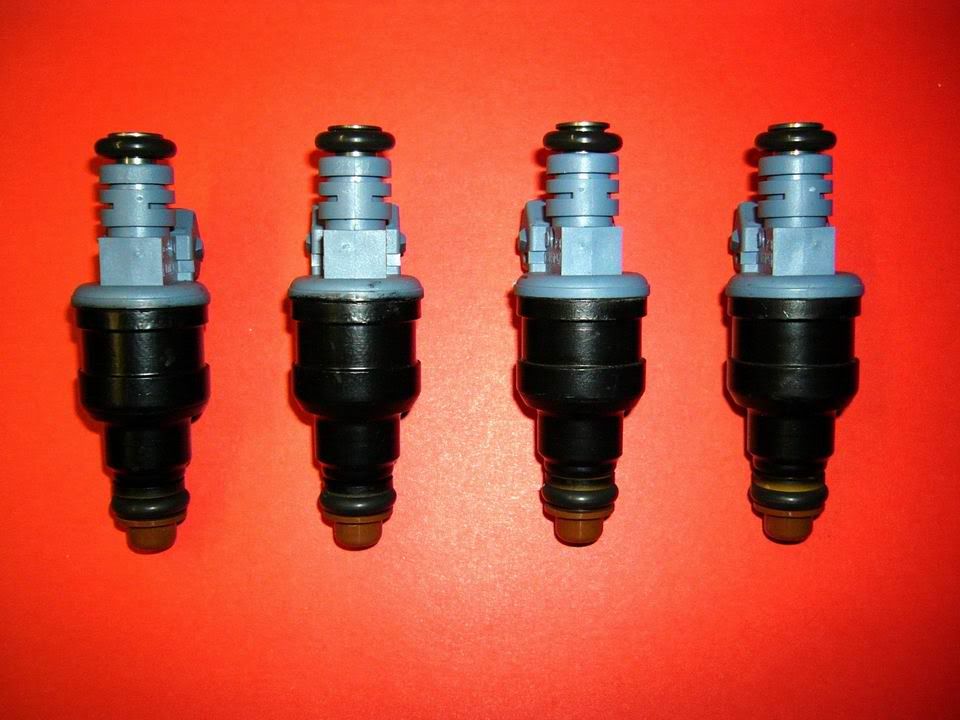
The pair of secondaries have had to be inreased in flow from the standard 190cc/min to 250c/min. Bizarrely, these are actually high impedance (16 ohm) saturated type injectors. These injectors operate at a fixed frequency of 128 Hz, with the quantity of fuel delivered dependent only the pulse width sent by the ECU - a bit pony, but hey-ho.

The standard S4 ECU (GM "Memcal") fuel mapping only triggers the secondary injectors over 4800 rpm and 0.7 bar boost. The increase to 250 cc/min items is required when running above the factory airflow / boost, as now the EPROM has been changed to allow the turbo to go to a heady 1.3 bar. Strangely (well in Cossie tuning terms), the ECU only goes into "open loop" mode above 94% throttle openings, and only in open loop mode is there no feedback to the ECU from the lambda sensor. So ONLY when the throttle goes above 94% is the fuelling based on the new pre-stored fuel maps in the EPROM. Below 94%, the fuelling / ignition is entirely controlled via the lamda / knock sensor readings (so much more like a modern car - not bad for 1994 technology LOL).
Finally the exhaust was changed to complete the tuning mods. This is a Blue Flame turbo back system, and has made a massive improvement in both looks and noise.
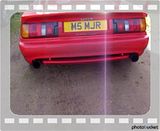
After final tweeks on the rolling road (changing the actuator for a stronger item to hold the wastegate closed), the car produced more at the wheels (278bhp), than the original is "supposed" to produce at the flywheel. Which works out at a calculated flywheel figure of 328bhp and 350lb ft of torque. The car now goes like it looks and would murder any of the standard V8 cars (less weight, 55lb ft more torque) and is an absolute joy to drive, with a relaxed muscular feel with more power and torque everywhere in the rev range. Even with the 285 tyres and weight over the back, traction is a struggle in the first two gears (whereas before full throttle in the WET was not an issue with the old 245 tyres LOL).
Next installment will detail the body mods .
.
As standard the Esprit is pretty crap, it has terrible brakes (260mm with sliding callipers) and the alleged factory 264bhp is supposed to be complimented by a 6s over-boost to 280bhp. The reality is that the factory charge-cooler is pretty poor and these figures are only ever achieved in ideal conditions and for only limited periods before the charge air retard within the map pulls the boost back due to seeing too high temps.
Anyway, the first thing that was done was to upgrade the brakes to the Brembo 4-pots and 330mm discs from the V8, which actually endowed the car with braking that could no longer be described as frightening, and just about adequate for a car of this weight and intended performance LOL:

Then when the turbo died on track at Snetterton back in 2006, it was time to do something about it. Now as you are probably aware from my other posts, I like to mod cars, so with my motto of not replacing stuff with standard items, the modifcations began:
The air flow figures of the standard turbo are the limiting factor if you want to make substantial gains in the performance of these cars. Even after changing the EPROM for more fuel, ignition and boost, you cannot get any more sustained power, due to the aforementioned shonky charge-cooling arrangement and small size of the turbo. The bottom line is that turning up the boost on one of these, quickly runs up against the fact that the standard turbo cannot flow enough air at the top end - the result is that the inlet temperature rises very dramatically and boost drops away. In fact, just like RS Turbos, there is common condition in which increasing the boost will actually produce less power output due to the inefficiency of the standard set up.
The S4 is fitted with a Garrett T3 turbo, comprised of standard 270° thrust bearings, 0.63 a/r "Lotus only" turbine housing (as a comparison the T3 on a Cossie (2.0 litre) is 0.48 a/r, but the Esprit is 2.2, so needs better exhaust flow) with an integral wastegate, a standard T3 compressor housing, and a 42 trim compressor wheel, oil fed and water cooled. It has a maximum flow rating of 25 lbs/min at a 1.2 bar of boost, with 58% efficiency. This gives you an idea of how bad the turbo is, as you take the air flow and add 25-30bhp (on a good VE engine) to give the maximum THEORETICAL achievable power with the turbo. Therefore, it was nearly maxed out as standard (and no doubt explains why it let go on track).
The cure? A bigger turbo and better charge-cooler! I chose to replace this with a super-duper hybrid version:

This is similar to the turbo on the S4S, the Garrett T3 turbo was modified by fitting a 60 trim compressor wheel and 360° thrust bearing etc. It has a maximum flow rating of 34 lbs/min at a pressure ratio of 1.3 bar of boost, with 64% efficiency.
Next we move on to the intake system, as there is a lot of air flow lost from the turbo to the throttle body inlets. This was looked at by some racing teams a few years ago, and they found that the standard inlet system lost over 30 cfm of airflow from turbo to the inlet ports . However, with a little matching of the inlet manifold to the ports, gas flowing the nozzle and plenum you could get this down to about 7-8 cfm loss. The race team got the losses from turbo to inlet on the GT1 car down to less than 5 cfm losses! The entry of the nozzle to the plenum is quite restrictive as you can see from the photos. Over 5mm was machined from the entry of the nozzle to the plenum and all the edges were radiused off and matched to the individual gaskets.





All the 4-cylinder turbo-charged Esprit models since they were face-lifted from the original wedge shape (SE, S4, S4s & GT3) use a chargecooler (basically a water cooled intercooler) to reduce the intake temperatures. Unfortunately, in standard size these suffer from excessive heat soak, so are only good for short blasts of speed. Water is pumped via alloy pipes routed through the chassis backbone, to a chargecooler radiator mounted ahead of both the air conditioning condenser and the engine cooling radiator.
The chargecooler system on our car has been extensively upgraded with a chargecooler double the size of the original. Although the cooling matrix is twice the size of the original, there is no loss in air flow. What results is a much greater cooling efficiency, so now combined with the bigger, more efficient turbo, the power should be much improved.



The rubber impellor of the charge-cooler pump is essential to achieve the intended performance from the engine. Sadly the standard item deteriorates slowly with age, progressively robbing power, but due to the slow period that this takes place - you don't notice
 ops:. The one on ours had actually siezed solid, meaning that the water was only running round due to thermal cycling (like a Model T Ford water system LOL). This impellor is custom made by a company in Germany using the highest quality and most appropriate rubber compound, so that it doesn't have to be changed all over again later in the car's life. Can't believe Lotus didn't do this in the first place :roll:.
ops:. The one on ours had actually siezed solid, meaning that the water was only running round due to thermal cycling (like a Model T Ford water system LOL). This impellor is custom made by a company in Germany using the highest quality and most appropriate rubber compound, so that it doesn't have to be changed all over again later in the car's life. Can't believe Lotus didn't do this in the first place :roll:.
While this was being done, it seemed the sensible time to sort out the rest of the cooling on the car, as the radiator had developed a leak and was believed to be due to the common Esprit problem of it basically having rotted. Sure enough, when everything was stripped off, all was revealed - the radiator was FUBAR'd - as you can see it looks like a bee-hive
 :
:
A close up of the main water radiator showing the leaking area - apart from being 50% blocked with road debris - it was as rotten as 6 week old road kill LOL. I think this was because it had always remained damp on the outside due to the sodden crud stuck to it over the years! The front spoiler is designed to channel a huge amount of airflow to the radiators - unfortunately with this comes the dirt and thousands of suicidal insects!

This was the offside oil cooler showing the broken outlet fitting.. Unfortunatley you need to remove this fitting so you can get to the radiator, which subsequently just fell off
 . As you can see it was in quite a poor condition generally - again down to the efficency of the spoiler and the fact that the flat floor prevents any cleaning access.
. As you can see it was in quite a poor condition generally - again down to the efficency of the spoiler and the fact that the flat floor prevents any cleaning access.
Nearside oil cooler showing damage causing a slight leak:

Here is the conjoined charge-cooler radiator and air-con condensor - the lower part is the air con. This appeared to have had a leak as there was no gas in the system! Seems a very inefficient set-up, so I realised this could be vastly improved upon
 .
.
Another view of air con / pre-rad:

Now the oil coolers have been replaced with brand new ones and the radiator upgraded and a HUGE charge-cooler radiator installed.
Here is the automotive sexual bit courtessy of Pro-Alloy Motorsport
 :
:
Moving on to the fuelling system, the standard primary GM-Rochester injectors are well known for not being the best injectors on this planet (i.e. cheap rubbish that Lotus obviously got from their American partners when they were linked to GM). In fact, its quite common that these are way out of spec from the factory and differ too much in flow with a terrible spray pattern. This can result in an uneven running engine, poor idle and last but not least has the potential to melt the engine when going for mor power shock: !
Step forward Cosworth tuning in the form of four Bosch "400" light blue injectors, matched, flow tested and checked for correct spray pattern. These are the same flow rate as the standard items and just bolt straight in - reslut
 .
.
The pair of secondaries have had to be inreased in flow from the standard 190cc/min to 250c/min. Bizarrely, these are actually high impedance (16 ohm) saturated type injectors. These injectors operate at a fixed frequency of 128 Hz, with the quantity of fuel delivered dependent only the pulse width sent by the ECU - a bit pony, but hey-ho.

The standard S4 ECU (GM "Memcal") fuel mapping only triggers the secondary injectors over 4800 rpm and 0.7 bar boost. The increase to 250 cc/min items is required when running above the factory airflow / boost, as now the EPROM has been changed to allow the turbo to go to a heady 1.3 bar. Strangely (well in Cossie tuning terms), the ECU only goes into "open loop" mode above 94% throttle openings, and only in open loop mode is there no feedback to the ECU from the lambda sensor. So ONLY when the throttle goes above 94% is the fuelling based on the new pre-stored fuel maps in the EPROM. Below 94%, the fuelling / ignition is entirely controlled via the lamda / knock sensor readings (so much more like a modern car - not bad for 1994 technology LOL).
Finally the exhaust was changed to complete the tuning mods. This is a Blue Flame turbo back system, and has made a massive improvement in both looks and noise.

After final tweeks on the rolling road (changing the actuator for a stronger item to hold the wastegate closed), the car produced more at the wheels (278bhp), than the original is "supposed" to produce at the flywheel. Which works out at a calculated flywheel figure of 328bhp and 350lb ft of torque. The car now goes like it looks and would murder any of the standard V8 cars (less weight, 55lb ft more torque) and is an absolute joy to drive, with a relaxed muscular feel with more power and torque everywhere in the rev range. Even with the 285 tyres and weight over the back, traction is a struggle in the first two gears (whereas before full throttle in the WET was not an issue with the old 245 tyres LOL).
Next installment will detail the body mods
 .
. I always felt that although the car looked good from certain angles, the OE 17" wheels just looked too inset.
However, I love the side on look of the later V8s with the OZ spoked wheels (the rear lights I'm definitely not convinced about) and originally wanted to replicate this with all OE parts.

Unfortunately, it was soon discovered that this wouldn't be possible due to Lotus falling out with OZ and these wheels were not available new. Fortunately I managed to find a similar two-piece split rim design from a company in Germany, so the spats were ordered from Lotus and when they arrived, the realisation of what it was going to take sunk in. It wasn't just a case of bolting them straight on and getting the car painted - EVERYTHING was different and required modifying the actual bodywork to fit (gulp). Having just spent a fortune on the wheels, there was no choice but to go ahead, so in for a penny in for a pound LOL:
This picture shows just how much of the body has to be removed:
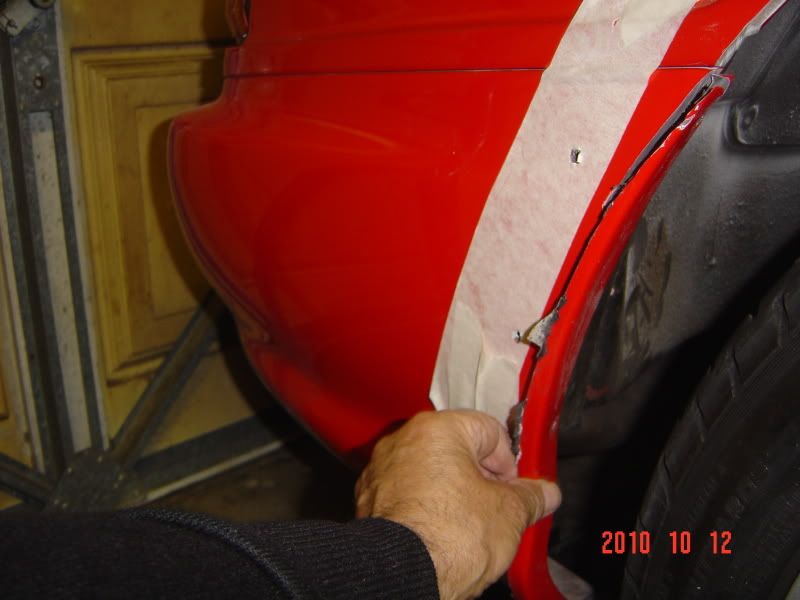
Holes drilled:
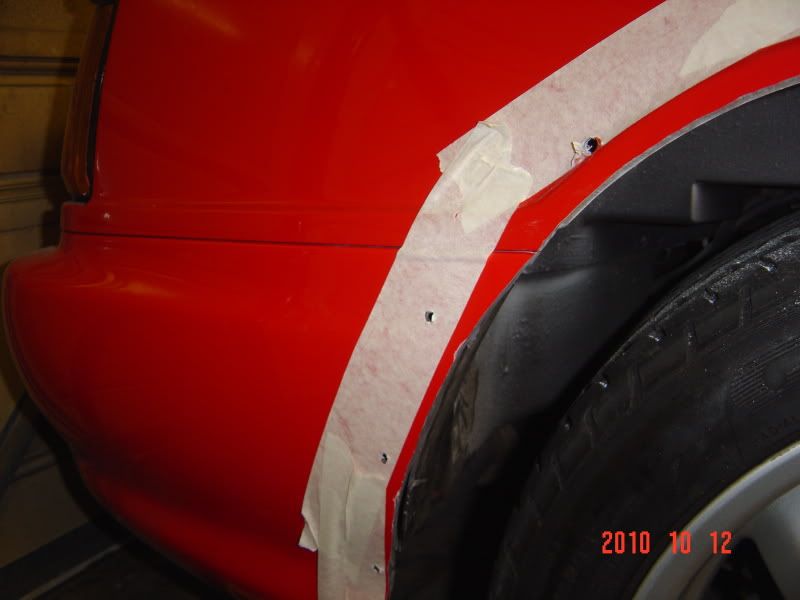
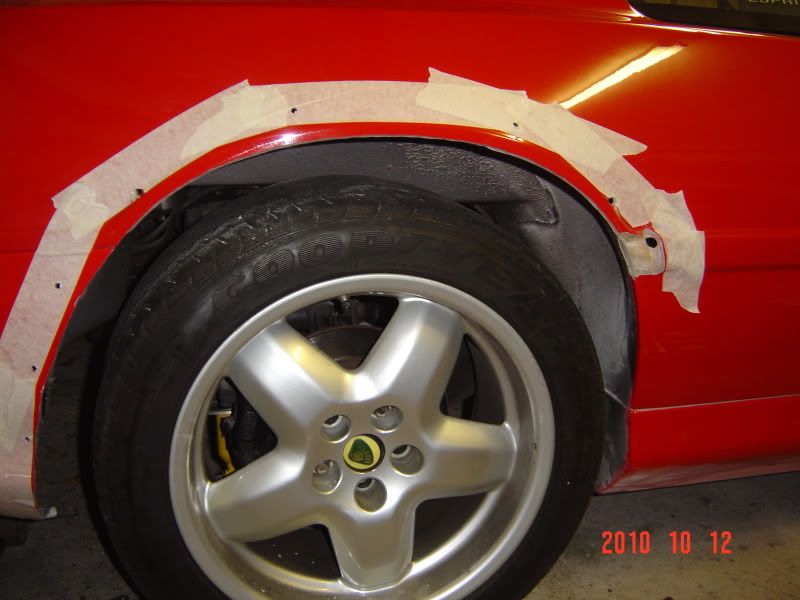
Centre swage moulding modified:
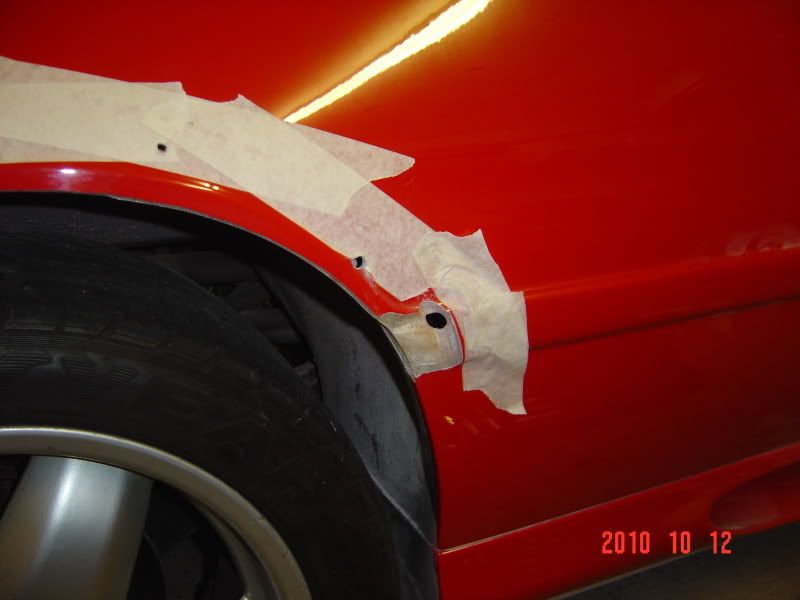
The side repeater has to be removed from the centre swage position as per this picture:
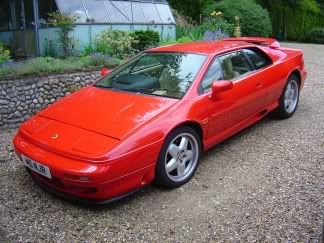
To just above in the wing, as per the V8s:

With help from contacts at Lotus, the mods were all carried out exactly how Lotus originally did the V8s (but with some custom stainless-steel clips being machined up where required) and with the paint done by the same guy that did my Escort it ended up like this (the stance is courtessy of the Lotus Bilstein Esprit suspension and spring kit):
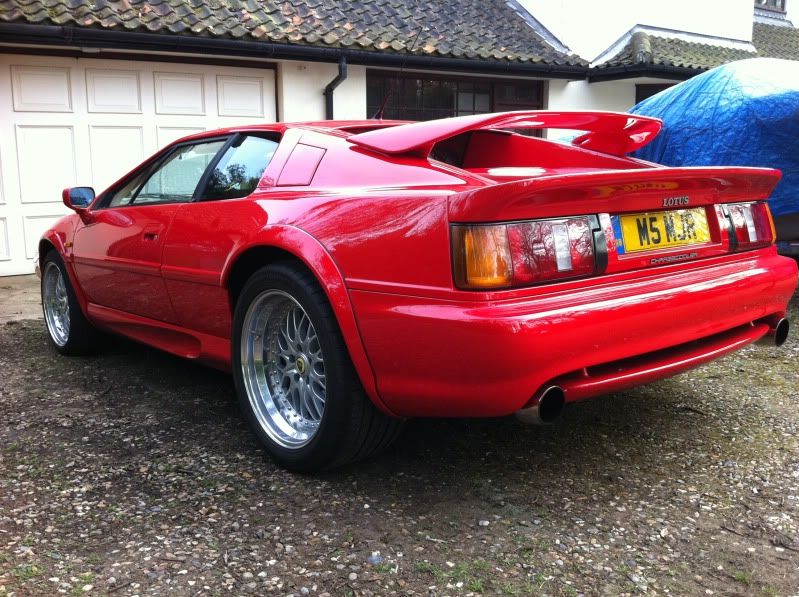
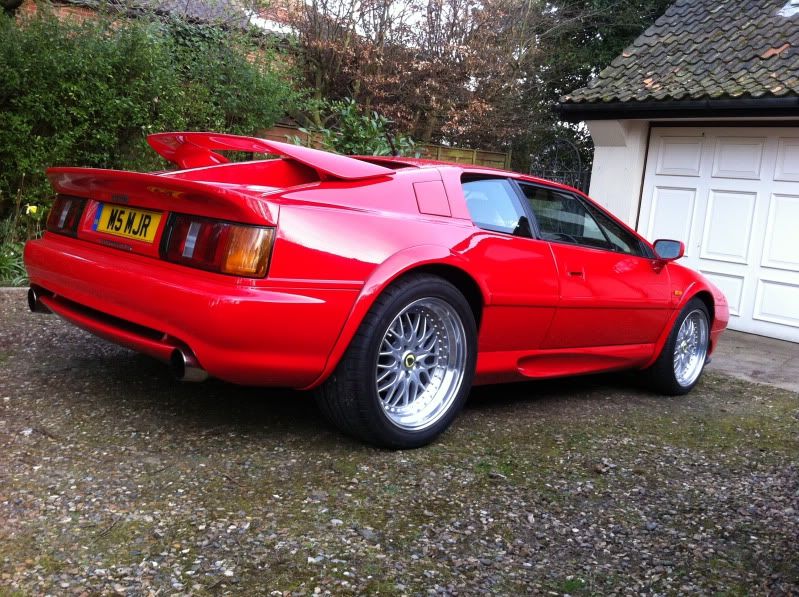
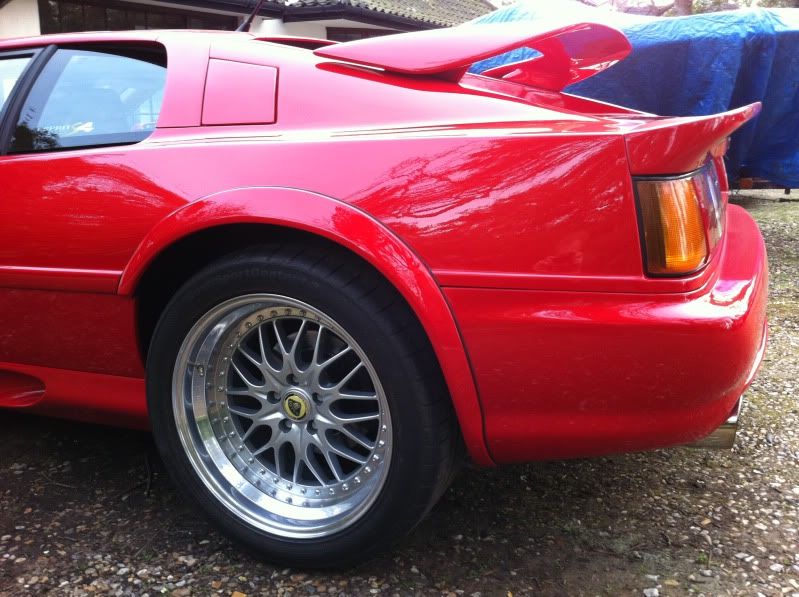
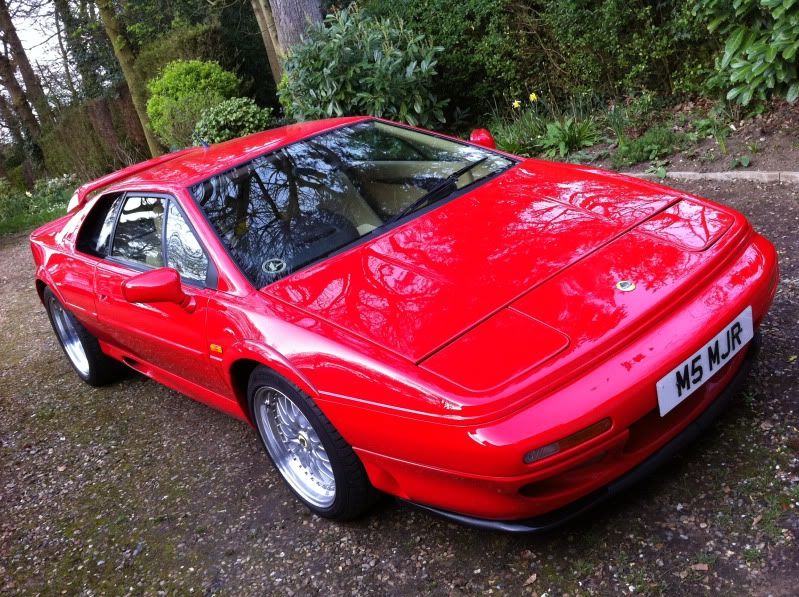
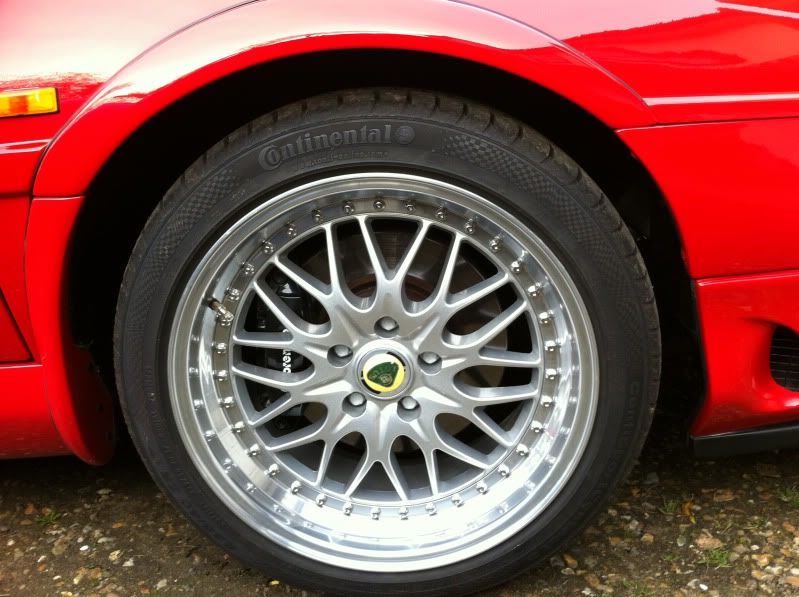

I suppose we should have just got an S4S LOL!
However, I love the side on look of the later V8s with the OZ spoked wheels (the rear lights I'm definitely not convinced about) and originally wanted to replicate this with all OE parts.

Unfortunately, it was soon discovered that this wouldn't be possible due to Lotus falling out with OZ and these wheels were not available new. Fortunately I managed to find a similar two-piece split rim design from a company in Germany, so the spats were ordered from Lotus and when they arrived, the realisation of what it was going to take sunk in. It wasn't just a case of bolting them straight on and getting the car painted - EVERYTHING was different and required modifying the actual bodywork to fit (gulp). Having just spent a fortune on the wheels, there was no choice but to go ahead, so in for a penny in for a pound LOL:
This picture shows just how much of the body has to be removed:

Holes drilled:


Centre swage moulding modified:

The side repeater has to be removed from the centre swage position as per this picture:

To just above in the wing, as per the V8s:

With help from contacts at Lotus, the mods were all carried out exactly how Lotus originally did the V8s (but with some custom stainless-steel clips being machined up where required) and with the paint done by the same guy that did my Escort it ended up like this (the stance is courtessy of the Lotus Bilstein Esprit suspension and spring kit):






I suppose we should have just got an S4S LOL!

Looking great!
I have a couple of questions
What secondaries did u go for, what are the alternatives...i.e what should I be searching for/asking for
I noticed that you used priamries from a Ford Cossie YB ... does that mean 'any' light blue cosworth injectors will work eg http://www.ebay.co.uk/itm/FORD-COSWORTH-COSSY-4WD-... ??
Last annoying question, are the intake modes a simple case of unbolt... dremel... wash down... and refit?
Okay I fibbed one more...what chip are you using?
thanks in advance
Emlyn
I have a couple of questions

What secondaries did u go for, what are the alternatives...i.e what should I be searching for/asking for
I noticed that you used priamries from a Ford Cossie YB ... does that mean 'any' light blue cosworth injectors will work eg http://www.ebay.co.uk/itm/FORD-COSWORTH-COSSY-4WD-... ??
Last annoying question, are the intake modes a simple case of unbolt... dremel... wash down... and refit?
Okay I fibbed one more...what chip are you using?
thanks in advance
Emlyn
Edited by s4s1995 on Wednesday 30th May 21:02
s4s1995 said:
Looking great!
I have a couple of questions
What secondaries did u go for, what are the alternatives...i.e what should I be searching for/asking for
I noticed that you used priamries from a Ford Cossie YB ... does that mean 'any' uprated YB injectors will work/be an improvement over standard 17yr old injectors? eg http://www.ebay.co.uk/itm/MI16-COSWORTH-YB-42LB-BO... only asking as the ones your used are mucho expensive
Last annoying question, are the intake modes a simple case of unbolt... dremel... wash down... and refit?
Okay I fibbed one more...what chip are you using?
thanks in advance
Emlyn
Hi Emlyn,I have a couple of questions

What secondaries did u go for, what are the alternatives...i.e what should I be searching for/asking for
I noticed that you used priamries from a Ford Cossie YB ... does that mean 'any' uprated YB injectors will work/be an improvement over standard 17yr old injectors? eg http://www.ebay.co.uk/itm/MI16-COSWORTH-YB-42LB-BO... only asking as the ones your used are mucho expensive

Last annoying question, are the intake modes a simple case of unbolt... dremel... wash down... and refit?
Okay I fibbed one more...what chip are you using?
thanks in advance
Emlyn
I went for the ones that Marcus at PUK Racing supplied with his Blue racing no. 7 chip
 .
.He also supplied the primaries, but I believe these are no longer available from Bosch (and for informational purposes, the 400 refers to the last three digits of the part number, not the flow rate - they're actually 476cc/min @ 3.0 bar fuel pressure). Obviously any low impedance injector can be made to work with the ECU, it's the actual mapping that is critical, as this has to match the fuel flow of the injector. Looking at Marcus's website, the injectors he now lists are different to what we bought (it was some years ago that the engine mods were carried out), so you're best speaking to him. His English is absolutely perfect and he has always been very helpful. I'd take the claimed power figures with a pinch of salt, he quotes 350-370bhp for the spec, but the reality was a perfect 328bhp from a very accurate Dyno Dynamics rolling road.
We also opted for his software, which enabled monitoring exactly what was happening on the runs, which showed that everything was working as it should (bang on 1.25 bar)
The porting was effectively done how you said, but all port matched so there were no steps by a very experienced Cosworth specialist.
Gassing Station | Esprit | Top of Page | What's New | My Stuff





 .
.